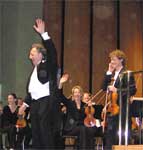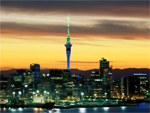THE NEW WEST SYMPHONY GIVES GREAT
BEETHOVEN IN SANTA MONICA
(in Oxnard and Thousand Oaks, too!)
By Laurence Vittes  Since its founding in 1995, the New West Symphony has lived a shadowy existence on the edge of the Los Angeles cultural scene. The Like the Pasadena and Long Beach Symphonies, the New West’s players are all professional musicians drawn from the rich pool of classical musicians in the Los Angeles region, many of whom play for other area orchestras as well as being active “session players” for film, television and audio recording in the entertainment industry. Part of the orchestra’s ongoing excellence and ability to maintain a consistent sound and style comes from music director Boris Brott, a world-class conductor of high standards and recognized achievements. When the NWS expanded a few years ago from their home base in Oxnard into the Performing Arts Center in Thousand Oaks (designed by Antoine Predock), it took another step towards a respectability worthy of its artistic quality and ambitions. Since its founding in 1995, the New West Symphony has lived a shadowy existence on the edge of the Los Angeles cultural scene. The Like the Pasadena and Long Beach Symphonies, the New West’s players are all professional musicians drawn from the rich pool of classical musicians in the Los Angeles region, many of whom play for other area orchestras as well as being active “session players” for film, television and audio recording in the entertainment industry. Part of the orchestra’s ongoing excellence and ability to maintain a consistent sound and style comes from music director Boris Brott, a world-class conductor of high standards and recognized achievements. When the NWS expanded a few years ago from their home base in Oxnard into the Performing Arts Center in Thousand Oaks (designed by Antoine Predock), it took another step towards a respectability worthy of its artistic quality and ambitions.
Now the Symphony has thrust deep into the heart of West Los Angeles with a series of six concerts scheduled from October through May at recently renovated Barnum Hall on the campus of Santa Monica High School. Their all-Beethoven concert on October 12 featuring one-time Wunderkind violinist Corey Cerovsek, demonstrated that deeply-satisfying symphonic music-making is not the province of the LA Phil alone. During the evening’s first half, comprising the most extravagant of the three, so-called “Leonore” overtures that Beethoven wrote for his opera Fidelio (before abandoning them altogether for the thematically unrelated, more compact “Fidelio Overture” he finally settled on) and the sunny Second Symphony, both Brott and the orchestra seemed to be finding their sea legs in the remarkably handsome but still unfamiliar acoustical space. The second half, however, was an entirely different affair, as the American-born but now Paris-based Cerovsek took Beethoven’s musical-narrative arc and brought out all of its considerable glory. The trick in this greatest of all the composer’s concertos is not merely to master the notes, but to enhance the notes with a rhetorical sense as sensitive as Olivier’s and an expressive range as introspective of Brando’s in a voyage of exploration to find the music’s heart and soul. Cerovsek certainly has the technical chops; aside from a slip here and there, he definitely had his way with the notes. But it was his musical instincts and structural elasticity that, with the full and equal complicity of Brott and the orchestra, carried the evening. The applause was so thunderous at the end that I thought the audience was going to rush the stage and carry Cerovsek off on their shoulders, perhaps to parade him down the Santa Monica Promenade just a few blocks away. Instead, he played two encores which the audience gobbled up. In addition to the outstanding music making, the New West Symphony experience included Brott and members of the orchestra and staff milling about with the audience at half time and after the concert was over, introducing themselves, answering questions, and generally making friends. On November 7 (Oxnard), 8 (Thousand Oaks) and 9 (Santa Monica - starting time 4 p.m.), Brott will conduct one of Grieg’s Peer Gynt suites, Beethoven’s unforgettable incidental music to a forgettable ballet called The Creatures of Prometheus, and Mussorgsky’s Pictures at an Exhibition as orchestrated by Ravel. For more info and tickets, call (866) 776-8400 or visit www.NewWestSymphony.org. As convenience dictates, you can enjoy the New West Symphony in Oxnard or Thousand Oaks. But you really owe it to yourself to check them out when they’re playing Barnum Hall in Santa Monica. The young and old and enthusiastic audience in attendance when I was there knew great Beethoven when they heard it. Imagine! Not having to traipse downtown to hear this quality of sound and music in LaLa Land.
LOUIS VUITTON REGATTA
ANNOUNCED IN AUCKLAND
International Match-Racing Series to be Sailed January – February 2009  A new yachting regatta will take place in Auckland early next year, to be called the Louis Vuitton Pacific Series. A new yachting regatta will take place in Auckland early next year, to be called the Louis Vuitton Pacific Series.
Auckland is New Zealand’s largest city, with a vibrant waterfront area set around a beautiful harbour. The regatta will be held during the height of the southern hemisphere summer, when New Zealand enjoys its best weather. Six teams are expected to compete, with confirmed syndicates including Emirates Team New Zealand and BMW Oracle. Races will be sailed in Emirates Team New Zealand yachts. A Louis Vuitton trophy will be specially created for the event, which is not associated with the America’s Cup.
ART INSTITUTE UNVEILS SPECTACULAR,
NEWLY CONSERVED EUROPEAN TAPESTRY
COLLECTION IN FIRST MAJOR EXHIBITION
The Divine Art: Four Centuries of European Tapestries on View
November 1, 2008-January 4, 2009 70 Rarely Seen, Monumental Textile Masterpieces on Display After thirteen years of extensive, state-of-the-art conservation work, 70 monumental tapestries from the permanent collection of the Art Institute of Chicago will be displayed in the largest tapestry exhibition ever mounted at the museum. The Divine Art: Four Centuries of European Tapestries--on view November 1, 2008 through January 4, 2009 --showcases a remarkable collection that has been in Art Institute storage for many years. Subject to one of the largest tapestry conservation projects ever undertaken by a private workshop, this exhibition presents these massive works of art at their best--dazzling the eye beyond expectation. The European tapestry tradition originated in about 1300 in France, Belgium, Flanders, and the Duchy of Brabant (modern-day Netherlands). The churches, royal courts, and wealthy families of Europe lavished vast sums of money on tapestries to decorate the walls of castles and abbeys. Artists designed tapestries in sets, series, or "chambers," depicting biblical themes and allegories, history and mythology, and representations of daily life. These pieces retained their status as the art form of kings, as affluent Chicago families began collecting them in the early 20th century. Select grand tapestries hung in the homes of such local patricians as the Deering family, the Allerton estate, and Potter Palmer's "Rhine Castle" on Lake Shore Drive. The Art Institute was fortunate to acquire such pieces as the result of various donations, ultimately boasting a collection of nearly 100 tapestries. The Divine Art marks a critical juncture in the history of these tapestries. The exhibition is the result of a heroic 13-year conservation effort that saved these 600-year-old tapestries from damage and decomposition. From 1995 until as recently as April 2008, Christa C. Mayer Thurman, the Art Institute's Christa C. Mayer Thurman Curator and Chair of Textiles, personally accompanied all 15 shipments to and from the De Wit Royal Manufacturer conservation lab in Malines, Belgium. The tapestries subsequently underwent cleaning and conservation processes in a state-of-the-art laboratory. Thurman was deeply involved in this process, looking upon it as her responsibility to transport each grouping of five to six meticulously rolled and packaged tapestries on their voyage, and determining how far to carry the conservation. Special funds were raised for this herculean project, one of the largest ever undertaken by the Art Institute. Research on the collection itself was funded by a Mellon publication grant for key scholars in the field. The Divine Art features textile masterpieces from the 15th through the 18th centuries that are massive in scale and breathtaking in scope. Key works include a series of 14 Baroque tapestries woven in Brussels circa 1680 that tell the stories of Caesar and Cleopatra, Zenobia and Aurelian. Another highlight is the panel Autumn from Les Saisons, designed by Charles Le Brun and woven at the Royal Manufacture of the Gobelins in Paris in 1710. An early masterpiece on view is from the Netherlands, dated 1485-1525, depicting the Holy Family with the infant Christ pressing the wine of the Eucharist. The exhibition also includes a recently acquired tapestry, The Emperor Sailing from the Story of the Emperor of China, woven at the Royal Manufacture at Beauvais circa 1710. These examples illustrate the depth and importance of the Art Institute's holdings, which are recognized as one of the most magnificent textile collections in the United States. The Divine Art will feature a symposium on October 31, 2008, with leading national and international scholars in the field of tapestry research, including Christa C. Mayer Thurman, the Christa C. Mayer Thurman Chair of Textiles at the Art Institute of Chicago and curator of the exhibition; Elizabeth Cleland from the Metropolitan Museum of Art; scholar Nello Forti Grazzini; Filip Vermeylen of Erasmus Universiteit Rotterdam; François-Pascal Bertrand from the University of Bordeaux; Charissa Bremer-David of the J. Paul Getty Museum; and, from the University of Louvain, Koenraad Brosens and Guy Delmarcel (emeritus). Additionally, the Art Institute, in conjunction with Yale University Press, will publish a fully-illustrated catalogue of the complete collection. Written by principal author Koenraad Brosens, The Divine Art catalogue also includes contributions from François-Pascal Bertrand, Elizabeth Cleland, Charissa Bremer-David, Nello Forti Grazzini, and Christa C. Mayer Thurman. It contains a section devoted to the conservation process by Yvan Maes De Wit, president of the laboratory responsible for the conservation. The highly accessible catalogue serves a rich and instructive history of the medium. The Divine Art: Four Centuries of European Tapestries is organized by the Art Institute of Chicago. The exhibition is curated by Christa Thurman, the Christa C. Thurman Chair of Textiles at the Art Institute. Major funding for the exhibition is generously provided by The Chauncey and Marion D. McCormick Family Foundation and the Julius Lewis/Rhoades Exhibition Endowment Fund. Additional support is provided by the Community Associates of the Art Institute of Chicago. Support for the catalogue is provided by The Andrew W. Mellon Foundation
|





